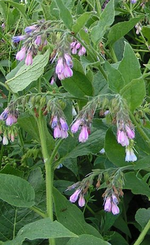|
Comfrey is one of those plants I like to keep in stock at all times, but especially in the summer, because of its powerful healing properties. We'll briefly investigate these properties and the usage cautions for this phenomenal herb in today's blog.
First the cautions (and this part has some controversy): Comfrey has a constituent called Pyrrolizidine alkaloid (PA). This alkaloid is known to be toxic to the liver when taken internally. In the leaves of Symphytum officinale, the PA content is 0.2% - 0.18%. In the roots, its 0.25% - 0.29%. For many hundreds of years, people traditionally used Comfrey both internally (in tea and salads) and externally (as salves and poultices). In more recent years, the discovery of the PA content has brought recommended cautions to avoid internal use and for women who are pregnant or nursing to avoid using it. At this time, I prefer to err on the side of caution and will focus on using Comfrey topically only, and avoid using it if pregnant or breastfeeding. The other caution I would give is to not use it on a puncture or infected wound until you are sure the infection is gone or the puncture is totally cleaned out. The leaves and/or root of the plant can be made into poultices or infused into teas or salves for topical use to help with burns, scrapes, scratches, minor cuts, bites, stings, bruising, skin irritations, broken bones, backaches, arthritis, varicose veins, hernias, and soft tissue injuries like sprains and strained ligaments. It does this by knitting tissue together through granulation. I have made several salves using Comfrey and can tell you that it heals wounds very quickly. When my grandson got a large scratch on his arm last year, I put a homemade salve containing Comfrey on it (after cleaning it.) Less than 24 hours later, the skin had completely sealed! (This is why it's best to not use it if there's an infection - you don't want to seal in the infection.) My favorite way to use Comfrey is to infuse dried Comfrey in a fixed oil like Castor or Jojoba (for improved absorption and shelf life). Once infused, I can then add the oil to a variety of products like salves, essential oil blends, and soaps. This is an herb well worth researching. Check out its datasheet in the membership portion of this website!
0 Comments
Leave a Reply. |
DisclaimerThe information contained in this blog is for educational purposes only and has not been evaluated by the Food and Drug Administration. Archives
March 2021
Categories |

 RSS Feed
RSS Feed